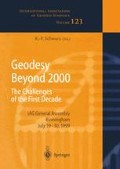Abstract
This study is concerned with the determination of a high resolution regional geoid in the area surrounding the Azores Islands, integrating multi-sensor airborne and marine observations with satellite derived and land gravity. It aims to prove the usefulness of airborne data in complementing existing marine and satellite derived gravity in coastal and insular regions, bridging the gap between land areas and the open ocean.
In the scope of the EU project AGMASCO (Airborne Geoid MApping System for Coastal Oceanography) several airborne gravimetric and altimetric campaigns have been performed. The new airborne and marine data used in this study have been collected in one of those campaigns, which took place in the Azores region, in October 1997. Profile and cross-over adjustments of the airborne to shipbome gravity suggest an accuracy of the airborne data of 4 to 5 mgal over wavelengths longer than 12 km.
Two geoid models have been computed using different data sets. The first was derived from all surface gravity (marine and land) merged with altimeter derived gravity anomalies. The second solution was computed from all previous data and airborne measured gravity. These solutions were called SURFACE and COMBINED respectively. Comparison of both solutions with the AZOMSS99 regional mean sea surface and with a set of GPSlevelling derived geoid undulations over the islands, shows that they agree very well. The difference between SURFACE and COMBINED solutions shows an average of 3 cm and a standard deviation of 4 cm. These results prove the ability of airborne data in complementing shipborne and satellite derived gravity for precise regional geoid determination.
Access this chapter
Tax calculation will be finalised at checkout
Purchases are for personal use only
Preview
Unable to display preview. Download preview PDF.
References
Andersen, O., and P. Knudsen (1998). Global marine grasvity field from the ERS-1 and Geosat geodetic mission altimetry, J. Geophys. Res., Vol 103, No C4, pp. 8129–8137
Bastos, L, S. Cunha, R. Forsberg, A. Olesen, A. Gidskehaug, L. Timmen, U.Meyer (1999). The role of airborne gravismetry in gravity field modelling: experiences from the AGMASCO project — Presented at EGS-99, the Hague, Holland, April 19–23, 1999, Accepted for publication in Physics and Chemistry of the Earth
Fernandes, M. J. (1999). Superficie media oceanica de alta resolugao na zona Azores-Gibraltar usando altimetria dos satelites ERS Cartografca e Cadastro n 10, pp 3–12
Fernandes, M. J., A. Gidskehaug, D. Solheim, M. Mork, P. Jaccard, and J. Catalao (1998). Gravimetric and Hydrographic Campaign in the Azores Region, 1Assemb. Luso-Espanhola de Geodesia e Geofcsica Almeria, Spain, February 9–13, 1998, to be published in the proceedings
Fernandes, M. J. L. Bastos, and J. Catalao (1999). The role of multi-mission ERS altimetry in the determination of the marine geoid in the Azores, Presented at INSMAP98, Melbourne, USA, Nov. 30 - Dec 4., 1998, submitted to Marine Geodesy
Harlan, R. B. (1968). Eotvos corrections for airborne gravimetry, J. of Geophys. Res. vol 73, pp. 4675–4679
Laurenço, N. J. M. Miranda, J. F. Luis, A. Ribeiro, L.A. Mendes Victor, Madeira, J & H. D. Needham (1999). Morpho-tectonic analysis of the Azores Volcanic Plateau from a new bathymetric compilation of the area, Mar. Geophys. Res., in press.
Olesen, A. V., R. Forsberg, A. Gidskehaug (1997). Airborne gravimetry using the LaCoste & Romberg gravimeter — an error analysis In: M. E. Cannon and G. Lachapelle (eds.), Proc. Int. Symp. on Kin. Systems in Geodesy Geomatics and Navigation Banff, Canada, June 3–6 1997, Publ. Univ. of Calgary, pp.613–618
Tsherning, CC.,.R. Forsberg, P. Knudsen (1992). Description of the GRAVSOFT package for geoid determination, Proc. 1st Coninental. Workshop on Geoid in Europe, Prague, pp. 327–334
Author information
Authors and Affiliations
Editor information
Editors and Affiliations
Rights and permissions
Copyright information
© 2000 SPringer-Verlag Berlin Heidelberg
About this paper
Cite this paper
Fernandes, M.J., Bastos, L., Forsberg, R., Olesen, A., Leite, F. (2000). Geoid modelling in coastal regions using airborne and satellite data: Case study in the Azores. In: Schwarz, KP. (eds) Geodesy Beyond 2000. International Association of Geodesy Symposia, vol 121. Springer, Berlin, Heidelberg. https://doi.org/10.1007/978-3-642-59742-8_18
Download citation
DOI: https://doi.org/10.1007/978-3-642-59742-8_18
Publisher Name: Springer, Berlin, Heidelberg
Print ISBN: 978-3-642-64105-3
Online ISBN: 978-3-642-59742-8
eBook Packages: Springer Book Archive

